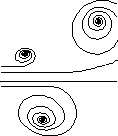Introduction to my Sandford Flemming Medal talk at the
Royal Canadian Institute for the Advancement of Science, May 4, 2006
Being in Space - An Exploration Through Art
First of all, thank you very much for this unexpected honour! I know a number of the previous honourees and feel very humble in their company.
So. Who am I?
I guess the best way to put it is that I am an artist who is exploring his own fascination with the human stuff that moves in air and in space. Flying provides us a unique perspective of where we are - and maybe what we are. I come at the art from a very constrained place, that is, I try to understand the technology and science to a good depth and use it in illustrating my own little vicarious voyage. Basically, I paint airplanes, spaceships and astronauts in their environment. But I want to make pictures that show more than what is possible with a camera.
I've flown many times in small aircraft, in jet fighters with lovely bubble canopies, and, of course, in airliners where I still press my nose against a scratched window when I am not pressing a camera against it. The pictures never turn out like those glorious vistas I remember seeing! For space - I've never been there and I likely never will, so I bug the ones who've gone. I've had many talks with astronauts about what they've experienced, and the overwhelming sense I get is that the pictures they take are almost frustrating for them to look at when they get back home.
Compared to a camera, the eye is an incredibly subtle instrument. You get a complete visual experience which is built up from many individual looks - into shadow; at brightness - your eye always adapting. And finally, for space, the things to see are so dramatic in their emotional scope that a camera cannot possibly record the experience completely. But I think I can come close. By using first-hand descriptions of what the space environment is really like, I try to construct a view that makes it real to me. When I'm successful, this exploration through art gives me the feeling of being in space. Ultimately, if I'm successful, I might be able to show the history of space exploration from a perspective that adds meaning to the experience as only art can.
Now, before you all shudder, I'll relate my fast and loose definition of art to this sloppy definition of science.
Science is the honest conversation with Nature. We ask Nature questions and if the forms of those questions are well made, It gives us answers. We build up a model of It that we modify and modify to get closer and closer to the "Truth." I'll use Truth in quotes and capitalized here to imply the all-encompassing mysterious thing that is the beating heart of reality. It is the Great Mystery anyway, and Science, by its very nature, cannot completely enclose this ineffible "Truth."
But that is what we are made of !
If you think about that hard enough you can get a special thrill when you just look at what is before your own eyes. The organs we use to create our consciousness certainly flow from the laws of the Universe working in each personal circumstance. The artistic response is one result.
I accept the view that art reveals the deep narrative-making structure of our brains and the way we inflect reality - how we impose order and reason, and even an answer to the great question Why?, on what may ultimately be incomprehensible. Art is the honest exploration of self relating to the world. It is unselfconscious, yet hyper-conscious. Real art only comes from what the artist is truly compelled to express, uncompromised by fashion but using or extending the artistic conventions that are understood by his or her society. Within this constraint, as long as I'm doing what I really want, I can say it is art. Doesn't mean it's good art. I might be nuts. I might be "bad" with pigment (or notes or words). But if I'm lucky I might touch something that is profound in Nature, of which I am a human expression, and bring it out in high relief so that others may see it in themselves.
To me spaceflight is the most dramatic example of what humans do. We are curious and creative. We look behind the face of the world and recombine what we find to give us new power and a new perspective. We can make a comfortable environment wherever we want. We can even take this environment into the heavens (via rocket).
The Apollo flights, nearly forty years ago, uniquely demonstrated that we can go far beyond what our physically weak design would seem to permit, and be almost anywhere in the Universe. I got to witness that for the first time when I turned sixteen in the summer of 1971. At the Kennedy Space Center press site, on the edge of the Turning Basin by the big countdown clock and flag, I experienced the launch of Apollo 15 to the moon.
It blew my mind.
From the Earth to the Moon - Spider Script



